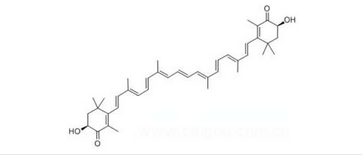Knowde Enhanced TDS
Identification & Functionality
- Chemical Family
- INCI Name
- Ingredient Origin
- Cosmetic Ingredients Functions
- Molecular Formula
- C40H52O4
- Odor and taste
- Slight algal smell, no corruption and other odors, no visible impurities
- CAS No.
- 472-61-7
- EC No.
- 207-451-4
- Technologies
- Molecular Structure

Features & Benefits
- Benefits
- Anti-oxidation & Anti-aging - The antioxidant activity of astaxanthin is equivalent to 10 times that of β-carotene and 550 times that of vitamin E. Astaxanthin can significantly reduce the damage of ROS and NMP to skin collagen and dermis elastin, thus ensuring the normal metabolism of skin. The structure of astaxanthin makes it easy to react with free radicals to scavenge free radicals, and play an anti-oxidant effect. Used in cosmetics, astaxanthin can prevent and delay skin aging and reduce the production of wrinkles and fine lines.
- Sun Block - Astaxanthin is a very effective photo-protective agent. It has its unique molecular structure. The absorption peak of its substance is about 470nm, which is similar to the UVA wavelength (380-420nm). Therefore, astaxanthin can absorb a large amount of UVA, which can effectively prevent ultraviolet radiation and eliminate free radicals caused by ultraviolet, thereby reducing the damage of ultraviolet rays to skin. In addition, astaxanthin can quickly restore skin damaged by UV burns.
- Characteristics
- Plamed adopts nano-emulsification technology, effectively solving the problems of poor water solubility and stability of astaxanthin.
- Plamed Astaxanthin is cosmetics grade and water-soluble; it is suitable for cosmetic formulation.
- Plamed Astaxanthin greatly increases the absorption efficiency and bio-availability.
- Plamed Astaxanthin can be soluble in water quickly, and without any precipitate.
Applications & Uses
- Markets
- Applications
- Skin Care Applications
- Sun Care Applications
- Source
- The source of astaxanthin is mainly divided into chemical synthesis and natural extraction. Astaxanthin is the final product of carotenoid synthesis, which is difficult to synthesize artificially and is mostly in cis structure. The US FDA only approves the trans-structure astaxanthin for industrial production. Natural extraction methods usually come from aquatic products, such as shrimp and crab shells, algae, etc.
- Natural astaxanthin mainly comes from Haematococcus pluvialis. The content of astaxanthin in Haematococcus pluvialis is 1.5%-3.0%, which is regarded as a “concentrate” of natural astaxanthin. Haematococcus pluvialis is considered as the best organism to produce astaxanthin in nature.
Properties
- Physical Form
- Appearance
- Red or deep red liquid
- Physical Properties
- Typical Properties
- Microbiological Values
- Heavy Metals
| Value | Units | Test Method / Conditions | |
| Methanol | max. 2000 | mg/Kg | - |
| 1,4-Dioxane | max. 30 | mg/Kg | - |
| Value | Units | Test Method / Conditions | |
| Molecular Weight | 596.84 | g/mol | - |
| Specification | 1 | % | - |
| Astaxanthin | 1 | % | - |
| Assay | 1% | - | - |
| Value | Units | Test Method / Conditions | |
| Total plate count | max. 1000 | cfu/g | - |
| Yeast & mold | max. 100 | cfu/g | - |
| E. coli | Negative | - | - |
| Staphylococcus | Negative | - | - |
| Salmonella | Negative | /10g |
| Value | Units | Test Method / Conditions | |
| Pb | max .1.0 | mg/kg | - |
| Cd | max .1.0 | mg/kg | - |
| As | max .1.0 | mg/kg | - |
| Hg | max .1.0 | mg/kg | - |
Safety & Health
- Safety
- Cosmetic, Toiletry &Fragrance Association (CTFA) has specifiedAstaxanthin as a cosmetics ingredient.
- Astaxanthinis included in The International Catalog of Chinese Cosmetic Raw Materials Standards in 2010 issued by CAFFCI.
- Astaxanthin is listed On the Announcement of Name List of Cosmetics Raw Material published by CFDA in 2021. No reports show its insecurity.
Packaging & Availability
- Packaging
- Sample bottles are 30ml and 50ml glass bottles.
- The products in small batches are packed in 1kg, 5kg and 10kg PE bottles.
- The outer packing of large quantity products is 200L aluminum bucket with aluminum plastic compound bag inside.
- Minimal Package - 1KG
- Minimal Order Quantity - 1KG
Storage & Handling
- Storage
Stored in a cool dry place and away from direct sunlight and oxidizing agents.
